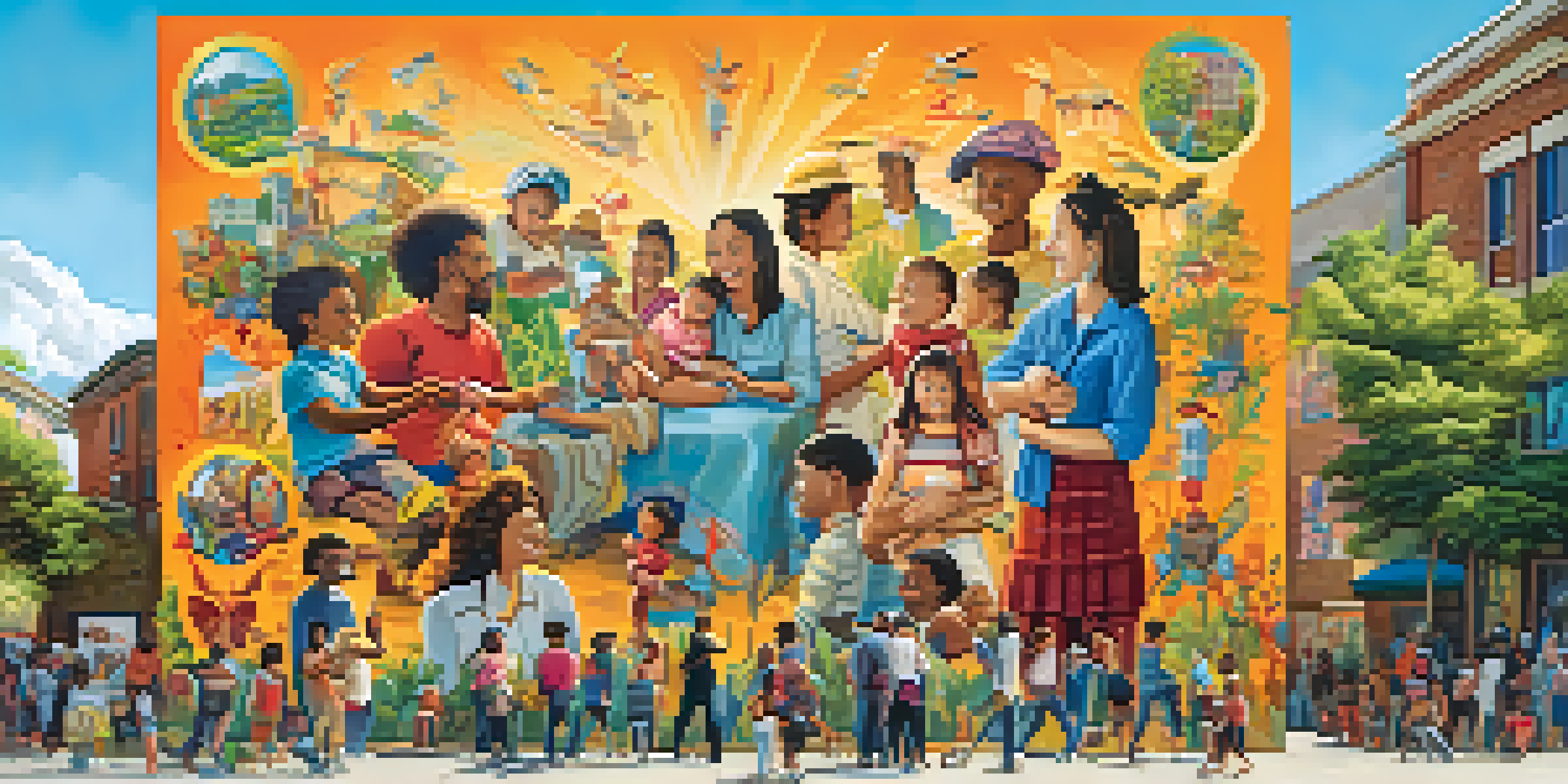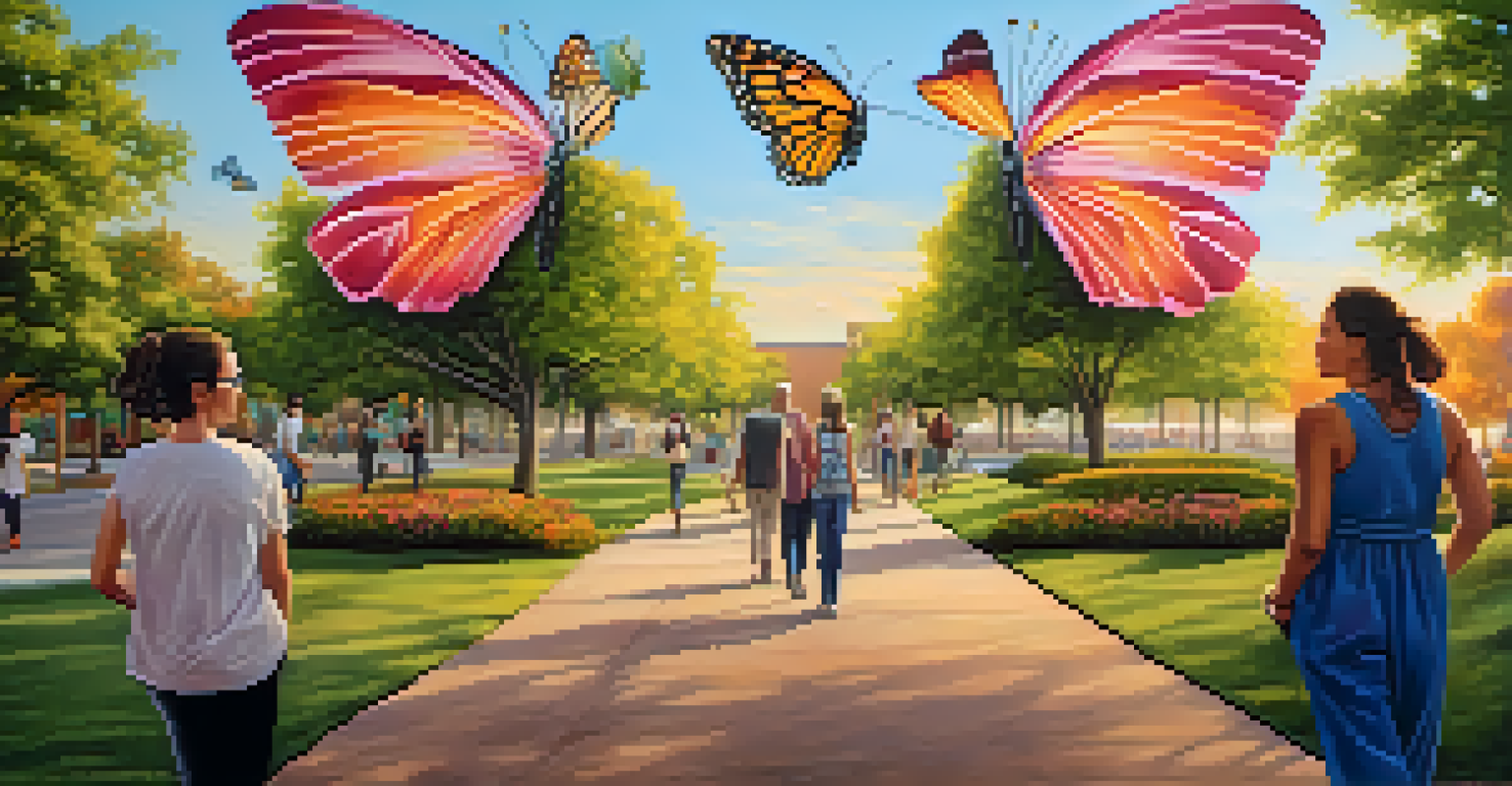The Power of Murals in Communicating Health Messages

Murals: A Vibrant Canvas for Health Awareness
Murals are more than just colorful wall art; they serve as powerful tools for health communication. By transforming blank walls into vibrant canvases, communities can convey essential health messages in an engaging way. These artworks not only beautify neighborhoods but also draw attention to pressing health issues that may be overlooked in traditional media.
Creativity takes courage.
Imagine walking down a street and coming across a mural depicting the importance of vaccination. This striking visual can spark conversations and encourage individuals to learn more about their health choices. Unlike flyers or pamphlets that can easily be ignored, murals have a unique ability to capture the public's attention and create lasting impressions.
Moreover, murals can resonate with diverse audiences, making complex health information more accessible. By incorporating local culture, symbols, and themes, these murals can speak directly to the community's values and beliefs, fostering a deeper understanding of health topics that matter to them.
Bridging Gaps with Visual Storytelling
One of the most compelling aspects of murals is their capacity for storytelling. Visual narratives can break down barriers and make health messages relatable to people from all walks of life. For instance, a mural illustrating the journey of a local cancer survivor can inspire hope and motivate others to seek screenings or support.

Through visuals, artists can convey emotions and experiences that words alone may struggle to express. This emotional connection can lead to increased empathy and action within the community. When individuals see their own stories reflected in art, they are more likely to engage with the health messages being presented.
Murals Enhance Health Awareness
Murals transform public spaces into vibrant platforms for communicating important health messages that resonate with community values.
Furthermore, murals can serve as conversation starters, encouraging discussions about health concerns. These open dialogues can lead to increased awareness and better health outcomes as community members share information and resources inspired by the artwork they encounter.
Fostering Community Engagement and Ownership
Murals often involve community participation in their creation, fostering a sense of ownership and pride among residents. When community members are actively involved in the mural-making process, they are more likely to internalize the health messages depicted. This collaborative approach not only enhances the artwork but also strengthens community bonds.
Art is not what you see, but what you make others see.
In many cases, local artists work alongside health professionals to ensure that the messages are accurate and relevant. This collaboration can lead to more tailored health initiatives that resonate with the specific needs of the community. As a result, murals become a reflection of local identity and shared values.
Moreover, community engagement through murals can spark interest in other health-related activities, such as workshops or health fairs. When people feel a connection to the art in their neighborhoods, they are more likely to participate in initiatives aimed at improving their overall well-being.
Enhancing Mental Health Awareness Through Art
Murals can also play a crucial role in promoting mental health awareness. With mental health issues often stigmatized, vibrant artworks can serve as safe spaces for discussions and reflections. A mural that encourages mental health conversations can make individuals feel less isolated and more supported within their communities.
By depicting themes of resilience, hope, and recovery, murals can inspire individuals struggling with mental health challenges. These visual reminders that they are not alone can empower people to seek help and share their experiences. Art has a unique ability to transcend words and connect people on a deeper emotional level.
Community Engagement Through Art
The collaborative creation of murals fosters community pride and ownership, strengthening connections while promoting tailored health initiatives.
Moreover, mental health-focused murals can contribute to community healing. They can transform spaces into areas of reflection and support, reminding individuals of the importance of mental well-being amidst everyday challenges. This shift in perspective can help reduce stigma and encourage more open conversations around mental health.
Addressing Public Health Crises with Artistic Impact
In times of public health crises, such as pandemics, murals can serve as powerful tools for disseminating vital information. For example, during the COVID-19 pandemic, murals were created to promote handwashing, mask-wearing, and social distancing. These visual reminders can be more effective than traditional messages, as they catch the eye and resonate in ways that statistics often cannot.
The immediacy of murals allows for quick dissemination of health messages when they are most needed. Artists can respond to emerging health issues with timely and impactful designs that encourage community compliance and awareness. This adaptability showcases the role of art in supporting public health efforts.
Additionally, these murals can foster a sense of unity and resilience within communities facing challenges. By coming together to create and appreciate public art, residents can strengthen their collective identity, ultimately leading to more effective public health responses.
Murals as Cultural Reflections of Health Narratives
Murals often reflect the unique cultural narratives of the communities they inhabit, effectively communicating health messages in context. When health artists incorporate local customs, traditions, and symbols, they create a more meaningful dialogue around health topics. This culturally responsive approach ensures that health messages are not only heard but also understood within the community's framework.
For instance, a mural depicting traditional healing practices alongside modern health initiatives can bridge the gap between old and new. By respecting and acknowledging cultural beliefs, artists can foster trust and openness to health messages that may otherwise be met with skepticism.
Cultural Reflections in Health
Murals that incorporate local customs and narratives create meaningful dialogues around health, bridging gaps between traditional and modern practices.
Moreover, cultural murals can serve as reminders of local health heroes and historical events that have shaped community health. These connections can inspire pride and motivate individuals to prioritize their health and well-being, ultimately leading to a more health-conscious community.
The Future of Murals in Health Communication
As communities continue to evolve, the role of murals in health communication will likely expand. With advancements in technology, interactive murals could emerge, allowing viewers to engage with health messages in innovative ways. Imagine scanning a mural with a smartphone to access valuable health resources or community events!
Additionally, as more organizations recognize the value of art in promoting health, we can expect increased funding for mural projects that focus on health education. This investment can lead to more opportunities for artists and health professionals to collaborate, creating impactful messages that resonate with diverse populations.

Ultimately, the future of murals in health communication looks promising. By harnessing the power of visual art, communities can continue to find creative ways to engage with health topics, inspire action, and build a healthier society together.